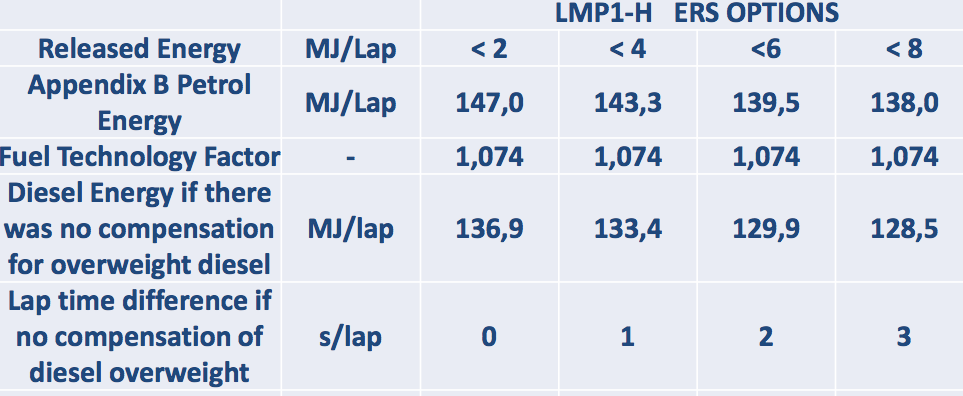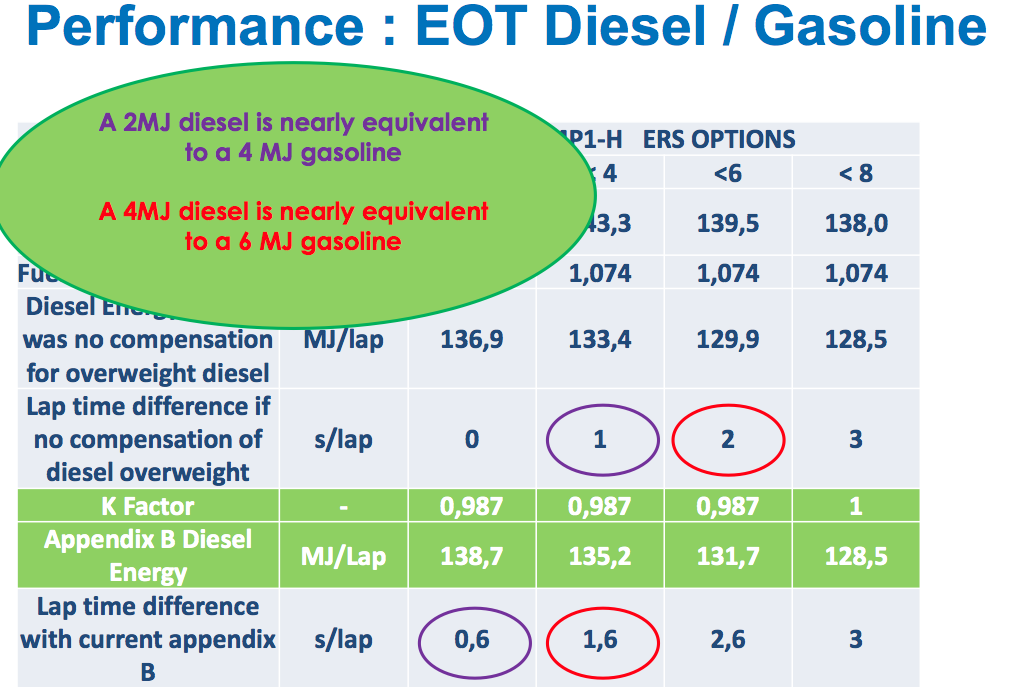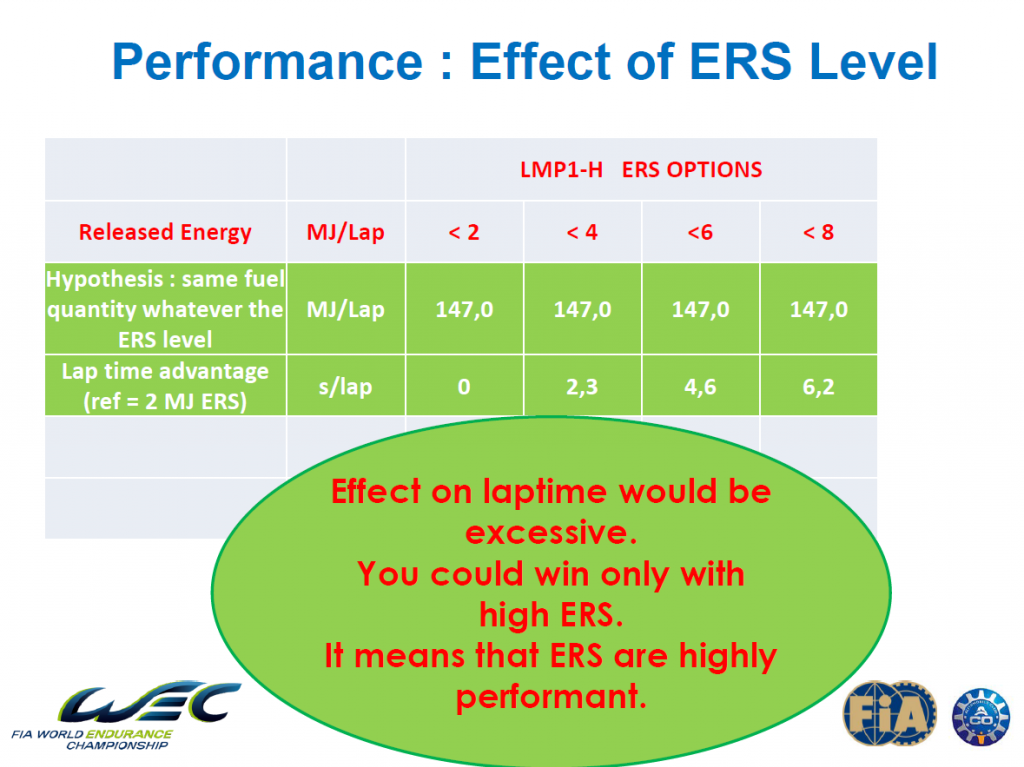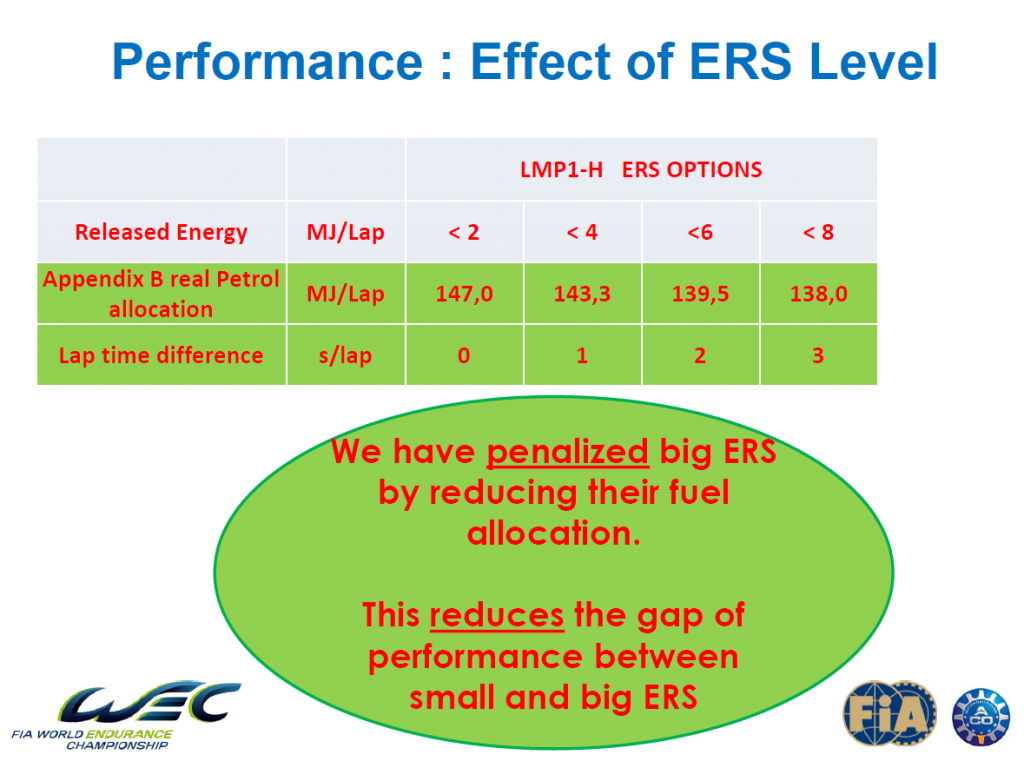|
| Site Partners: | SpotterGuides | Veloce Books |
| Related Sites: | Your Link Here |
|
||||||||||
|
||||||||||
|
|
#3576 | |||
|
Veteran
Join Date: Mar 2004
Posts: 8,738
       |
Quote:
Quote:
|
|||
|
|

|
|
|
#3577 | |||
|
Veteran
Join Date: Nov 2013
Posts: 734
 |
Quote:
ACO/FIA the only one to blame? Not necessarily. I believe the conservative strategy played out is also responsible. Most reigning champions fail in this way don't they? Playing on the safest bet only. |
|||
|
|
__________________
Eat, sleep, race, repeat. 
|
|
|
#3578 | ||
|
Veteran
Join Date: Sep 2009
Posts: 6,199
           |
Quote:
Richard |
||
|
|

|
|
|
#3579 | |||
|
Veteran
Join Date: Feb 2013
Posts: 2,132
    |
Quote:
What really came as a surprise was the explicit introduction in the EoT decision of last December of a further incentive (on top of the aforementioned autonomy-related incentive) that each additional MJ released by the ERS should amount to a theoretical gain of 0.5 second per lap at LM. It is still very confusing as to why the ACO-FIA apparently believed that it was necessary to include this new provision as part of the EoT process on top of the already existing "incentive". I very much believe that Audi were satisfied, at the time they made the choice to run in the 2 MJ/lap ERS class (which choice was made in late 2012-early 2013 already), that they could live with the autonomy deficit that inherently came with this option. They most likely were not expecting the ACO-FIA to subsequently introduce a new provision which would worsen the situation for them. It is worth noting once again that this new provision is not explicitly included in the LMP1 Technical Regulation per se, but has been "subtly" introduced via the EoT process by way of the Endurance Committee's decision of last December. Last edited by MyNameIsNigel; 7 May 2014 at 14:41. |
|||
|
|
__________________
In order to finish first, first you have to finish 
|
|
|
#3580 | ||
|
Veteran
Join Date: Sep 2009
Posts: 6,199
           |
Quote:
Maybe the ACO/FIA felt the incentive was not working well enough? Especially given that Audi felt that the least attractive option (from an ACO/FIA perspective) was workable for them? In short, while the 2 MJ/lap option was available, they didn't want anyone to really consider using it? Or maybe the "disincentive" wasn't strong enough for the lower energy hybrid solutions? Richard |
||
|
|

|
|
|
#3581 | |||
 Race Official Race OfficialVeteran
Join Date: Oct 2007
Posts: 16,632
           |
Quote:
that sounds plausible. Personally, I would have liked to see the rules allow factories to use a non hybrid option with a lower weight just like the privateers. If the rules are all about energy allocation than this should be workable. |
|||
|
|

|
|
|
#3582 | ||
|
Veteran
Join Date: Sep 2009
Posts: 6,199
           |
Quote:
So two points/theories... They may not want well funded teams to build very well sorted out and reliable non (or low) hybrid solutions. Basically don't build a complete package (classic ICE PSU) like they have in the past. Let the privateers do that. And that for those who do build a high energy hybrid, they may be rewarded with an incentive given the potential fragility. So someone like a Toyota or Porsche might win, if they keep it all together. Or Audi might win via a lower pace, but with better reliability. This is speculation on my part as to the ACO/FIA thinking. I don't particularly support those ideas other than I do think that putting privateers and factory teams on equal footing will just suck the life out of privateer entries. I do think the P1-H rules should be equitable and not a moving target. Richard |
||
|
|

|
|
|
#3583 | |
|
Veteran
Join Date: Sep 2010
Posts: 15,618
       |
So in the original draft, the rules were saying something along the lines of "more hybrid, more laps". Nothing about more speed. What happened at Silverstone pretty much showed this. Spa as well. I know Audi were off pace with their cars, but are the rules to blame? Im leaning more towards it being the nature of the cars relative to the circuit and the LM spec R18 being brand new with the #3 drivers.
|
|
|
|

|
|
|
#3584 | ||
|
Veteran
Join Date: Dec 2006
Posts: 8,962
      |
I largely agree. I don't agree with how the EOT seemed to be applied, but based on what I've seen so far, when their cars are in comparable aero trim, Audi and Toyota overall seem to be about equal. Audi are a bit better in the corners and under braking, and maybe with tire wear, while Toyota has slightly better top speed.
On tracks where downforce and tire life matter more, I'd expect the Audi to shine. At Spa, even when running nearly identical lap times, it's hard to defend against someone who could run about 15-20 miles an hour faster down the straights, even if they give it all back in the twisty bits unless they really run off their tires or make a driver error. But that was Toyota/Porsche LM areo vs Audi high downforce aero. If Toyota and Porsche were in high downforce trim, the gaps would've been much closer on all fronts. Audi may benefit in later WEC rounds because there, tire wear and aero becomes a lot more important than at LM or even Spa. We do also have to remember that the #3's cause wasn't helped by having basically rookie drivers on the squad and not having Olly or Marc in the car to provide an experienced hand. I don't think that we've quite seen everything from Audi yet as far as what they're really capable of. They screwed up with rain tire strategy at Silverstone though when it was dry they gave Toyota a helluva hard time. If the aero packages were more similar between the #1 and #2 R18s in the Toyota/Porsche camps, they'd probably have been on them like white on rice, and Joest still seems to have a slight edge on pit stops and strategy. I think it's pretty premature, even if Audi did kinda get shafted a bit by how the EOT got applied as far as time line went, to write them or anyone off as far as the LMP1 factory teams. Hell, even Porsche might surprise and be more reliable than we think. Audi could be faster than we think, and Toyota could have issues we don't think they have. There are all new cars with bugs in them and huge development potential as well. It's pretty much anyone's game depending on LM test day results, and considering different programs for each team and variables (cough, cough, weather), that might not provide a clear answer either. |
||
|
|

|
|
|
#3585 | ||
|
Veteran
Join Date: Jan 2012
Posts: 575
 |
The thing is that this EoT ERS incentive hasn't been clarified in anyway shape or form. In the last EoT Appendix B decision, it wasn't even mentioned...
We really won't know what it means till the FIA choose to clarify it (if it's an incentive for bigger systems or to offset the packaging issues with bigger systems) or till Sunday at Le Mans. I think Spa showed that on the whole, Audi are there. I'm scratching my head about the #3 low drag car though, more test milage in probably what Audi has planned. Hopefully they can iron out any issues with the aero package come Le Mans. Quote:
Why people are assuming that the most dominant factory team in the modern era will be unable to compete I don't know. The level of vitriol based on utter speculation is laugable.... Last edited by aneesh99; 7 May 2014 at 22:34. |
||
|
|
__________________
You must always strive to be the best, but you must never believe that you are - Juan Manuel Fangio 
|
|
|
#3586 | ||
|
Veteran
Join Date: Feb 2013
Posts: 2,132
    |
There you go. Here are relevant extracts of last Friday's ACO-FIA press conference (source: endurance-info.com)
   There is however still something that is not very consistent in the above numbers. For instance, the fuel autonomy of a 6 MJ petrol is supposed to be 13.9 laps/stints and the corresponding maximum allowable fuel consumption figure for that option is supposed to be 4.79 l/lap. With that maximum allowable fuel consumption figure and a fuel tank size of 68.3 l, the minimum fuel autonomy should however be of 68.3 / 4.79 = 14.26 laps/stint  Similarly, the fuel autonomy of a 2 MJ diesel is supposed to be 13.2 laps/stints in the above table, but the maximum allowable fuel consumption indicated in the table (3.95 l/lap) should lead to a minimum fuel autonomy of 54.3 / 3.95 = 13.75 laps/stint  I am sure that the ACO-FIA could do MUCH MUCH MUCH better in trying to explain the issue. The more they release "clarifications", the more obscure it gets... |
||
|
|
__________________
In order to finish first, first you have to finish 
|
|
|
#3587 | |
|
Veteran
Join Date: Mar 2004
Posts: 8,738
       |
I guess that the stint length calculations assume that the fuel tank will not be run completely dry. So there will be e.g. at least 1 liter left when they pit.
|
|
|
|

|
|
|
#3588 | |||
|
Veteran
Join Date: Mar 2002
Posts: 4,354
       |
Quote:
Also Audi do have a habit of being relatively quicker at LM than in the early races. Reading between the lines and with no technical knowledge I think Audi have had technical or reliability issues with their hybrid systems. They dropped the second system quite late so to say they decided on the 2MJ route 2 years ago begs the question as to why they were still testing the second system. |
|||
|
|

|
|
|
#3589 | |||
|
Veteran
Join Date: Feb 2013
Posts: 2,132
    |
Quote:
There was a good reason to do that, namely that the technical regulations only formally limit the amount of energy that is released through the MGU(s). The amount of energy that can be stored is not limited. Likewise, the amount of energy that would have been used to power the ERS-H to reduce turbo lag is "free" and not subject to any limitation. It should be reminded that a MGU is specifically defined in the regulations as being an electrical machine connected to a drive train. An electrical machine coupled to the turbine of the pressure charging system is not a "MGU" in that sense. In other words, Audi were most likely still testing with the ERS-H as late as in December 2013 (the ERS-H was announced when the car was first presented on December 18th, 2013) as part of the development/testing of the pressure charging system of their V6 TDI, even though they had already made the choice to run in the 2 MJ ERS class more or less a year before. |
|||
|
|
__________________
In order to finish first, first you have to finish 
|
|
|
#3590 | ||
|
Veteran
Join Date: Feb 2013
Posts: 2,132
    |
|||
|
|
__________________
In order to finish first, first you have to finish 
|
|
|
#3591 | ||
|
Veteran
Join Date: Sep 2010
Posts: 15,618
       |
Quote:
 They must have had issue with the flywheel. Be it weight, packaging, who knows. My thoughts are they played it safe by going 2mj. They must have had issue with the flywheel. Be it weight, packaging, who knows. My thoughts are they played it safe by going 2mj.
|
||
|
|

|
|
|
#3592 | |
|
Veteran
Join Date: Mar 2014
Posts: 614
 |
That inconsistency is strange, maybe a reserve that is not disclosed? If you recalculate you will see that for fuel density they used:
- 139.5 / 4.79 = 29.1 MJ/L for petrol - 138.7 / 3.95 = 35.1 MJ/L for the diesel Those are smallest numbers that I have seen, if we use the same numbers on the SPA circuit you get max laps on max consumption: - 6 MJ petrol: 68.3 L / (79.6 MJ/lap / 29.1 MJ/L) = 24.9 laps (actually 24,25) - 6 MJ diesel: 54.3 L / (75.1 MJ/lap / 35.1 MJ/L) = 25.3 laps - 2 MJ petrol: 68.3 L / (83.9 MJ/lap / 29.1 MJ/L) = 23.6 laps - 2 MJ diesel: 54.3 L / (79.1 MJ/lap / 35.1 MJ/L) = 24.1 laps (actually 23,24) - No ERS Petrol: petrol: 68.3 L / (89.7 MJ/lap / 29.1 MJ/L) = 22.1 (actually 22) Petrol 29.1 MJ/L number seems low, were this tables actually presented to the press by ACO or did the press do all the calculations on their own? Considering the tables are in English and it's a French article then those images are definitely not from the French  Do we have the closest official numbers for volumetric energy density? E20 petrol: 29.1 MJ/L B10 diesel: 35.1 MJ/L |
|
|
|

|
|
|
#3593 | |||
|
Veteran
Join Date: Feb 2013
Posts: 2,132
    |
Quote:

|
|||
|
|
__________________
In order to finish first, first you have to finish 
|
|
|
#3594 | |
|
Veteran
Join Date: Mar 2004
Posts: 8,738
       |
One of the other slides of the ACO presentation explicitely states that 1 MJ petrol fuel = 0.0343 liter. So that means 29.15 MJ/liter.
|
|
|
|

|
|
|
#3595 | ||
|
Veteran
Join Date: Feb 2013
Posts: 2,132
    |
There is a further slide in the ACO-FIA presentation that indicates what would be the expected lap time advantage of the various petrol ERS options assuming that all options would get the same fuel allocation as the 2 MJ petrol option (i.e. 147 MJ/lap). This slide indicates that the expected lap time advantage (compared to the 2 MJ petrol option) would be:
4 MJ petrol: 2.3 seconds/lap @LM 6 MJ petrol: 4.6 seconds/lap @LM 8 MJ petrol: 6.2 seconds/lap @LM  Where those numbers come from is a mystery, but this highlights that the ACO-FIA assumes, in the case of petrol, that: - the 4MJ ERS alone is worth 2.3 seconds/lap @LM over the 2 MJ ERS, - the 6 MJ ERS alone is worth 2.3 seconds/lap @LM over the 4 MJ ERS, and - the 8 MJ ERS alone is worth 1.6 seconds/lap @LM over the 6 MJ ERS. Indeed, since the fuel allocation is supposed to be the same in each case, this fuel allocation is not supposed to play any role in the expected lap time gain. Now, one can note that there is not even a linear evolution in the expected gain in lap time, the lap time gain resulting from switching from the 6 MJ to the 8 MJ ERS option being smaller. This is a bit strange. Now, the ACO-FIA claim that they have adjusted the fuel allocations to reduce the advantage of the bigger hybrids:  Let's take the 4 MJ ERS option as example. The relevant fuel allocation for petrol is: 143.3 MJ/lap, i.e. a difference of 3.7 MJ/lap (=147.0-143.3) compared to the 2 MJ ERS option. According to the ACO-FIA, the expected lap time gain should be of 1 s/lap @LM. One could therefore draw the conclusion that, in the case of petrol, the 3.7 MJ/lap difference amounts to a lap time gain of 1.3 s/lap @LM (=2.3-1), i.e. 0.351 s for each MJ of petrol allocation (=1.3/3.7). If you do the same calculations for the 6 MJ and 8 MJ petrol options you end up with the following figures: 6 MJ: (4.6-2) / (147.0-139.5) = 0.347 s for each MJ of petrol allocation 8 MJ: (6.2-3) / (147.0-138) = 0.355 s for each MJ of petrol allocation It would therefore seem that the ACO-FIA estimate that each MJ of petrol allocation amounts to a lap time gain of approximately 0.350 s/lap @LM. The lap time gain of 1.4 s/lap @LM in favour of a 6 MJ petrol LMP1-H (i.e. Porsche / Toyota) compared to a 2 MJ diesel LMP1-H (i.e. Audi) therefore "amounts" to approx. 4 MJ/lap of petrol fuel allocation. In that respect, the claim that a petrol LMP1-H benefits of a comparatively greater fuel allocation for the sole purpose of artificially increasing performance is ENTIRELY CORRECT. In that respect, the ACO-FIA's "clarifications" and attempt to demonstrate that Audi's claims in the media are allegedly "incorrect" is a TOTAL FAILURE. Last edited by MyNameIsNigel; 8 May 2014 at 11:30. |
||
|
|
__________________
In order to finish first, first you have to finish 
|
|
|
#3596 | |
|
Veteran
Join Date: Mar 2014
Posts: 614
 |
.. and fuel allocation per lap is not the only restriction, you have to count on the fuel flow also.
Fuel flow will determine actual engine power and for better lap time you could use more fuel flow out of the corners and then use low throttle at higher speed to meet fuel limit per lap. Would that not work for better lap time and same lap fuel allocation? |
|
|
|

|
|
|
#3597 | ||
|
Veteran
Join Date: Dec 2006
Posts: 8,962
      |
Another thing is that the ACO/FIA stuff doesn't take into account is a vehicle's areo package and what impact that might have on both speed and fuel economy. Audi make up a ton of time in the corners, so maybe they can coast down shorter straights to make up fuel economy. Or because they have more downforce, they don't have to use the brakes as much and can "float" (coast) the car though corners and use the car's momentum and grip to do the work. That also conserves tires.
I do buy that the ACO is trying to push an agenda with the hybrid systems as a part of their "green" movement, though hybrid systems on road cars long term currently can't be argued as being any "greener" than clean diesel, ethanol, or normal gasoline (the heavy metals and chemicals used in batteries mainly). But at the same time, the ACO have yet to clarify if the gap is supposed to be actual or theoretical. That's where I think that the ACO/FIA are screwing up. Is the 1.4 gap supposed to be in theory, aka, on paper, or is it supposed to be actual. Did the ACO take into account that Audi could make up a lot of that gap though car design? Audi were on pace at Silverstone, and the second half of Spa, and we have yet to see what the veteran drivers can do with the LM car, and even the rookies late in the event were doing pretty well from what I've read and heard. The ACO/FIA being arbitrary, dancing around the topic, and getting defensive/somewhat offended it seems when Audi or the media have questioned some of their stuff does smack of agenda pushing on their parts, and not wanting to get caught with their pants down with their mistress while married. But at the same time, I have yet to see conclusive evidence on track--in reality, not on paper--that Audi are being severely handicapped in anyway by the rules. Audi may've lost much of the initial advantage that they had with EOT, but as of yet, it can't IMO be conclusively argued that they got locked out in the cold based on on-track results. And that's from a die-hard Audi fan who initially thought that they got shafted until they ran well early at Silverstone and what they did in practice there. And we have to remember at Silverstone that Toyota early on had issues with staying within their EoT limits while the Audis were attacking them. One advantage that Audi have is that automated EoT warning system, something that Toyota or Porsche have yet to introduce themselves. So who's right, and who's wrong. That can be IMO equally proportioned between Audi and the ACO/FIA at this stage as far as them being both right and wrong. The ACO are in the wrong for writing down stuff, black and white, on paper, that basically in attitude if not words does make it seem that they're pushing an agenda that rightfully or wrongfully seems to theoretically benefit Toyota and Porsche. Yet, at the same time, Audi's performance does make the ACO's "theories" seem a bit moot. Theories are always fine, until they're put to the test. And it seems that Audi's theory of being hamstrung by this seems a bit off, and if the ACO in theory said that they'd be over a second slower at LM, that has yet to be put to the ultimate test, but indications are that a 1+ second gap at LM on an average per lap during a stint also seems unlikely. |
||
|
|

|
|
|
#3598 | ||||
|
Veteran
Join Date: Feb 2013
Posts: 2,132
    |
Quote:
Quote:
This being said, that still means that Audi have to find ways to compensate that artificial 1.4-second deficit, and solutions are limited. They cannot work on the engine side to improve its efficiency as they will otherwise face a dissuasive penalty at LM. They can work on a variety of additional parameters including aerodynamic efficiency and car set-up, but can you find 1.4 second so easily by working on this parameters ? Assuming you can, that still implies that you need to do a far better job than the competition, and the competition is not standing still. They are also working hard on these aspects for sure. So, unless Audi can find a "miraculous" aero solution and/or car set-up for LM, there is hardly any chance that they can close that 1.4-second gap. |
||||
|
|
__________________
In order to finish first, first you have to finish 
|
|
|
#3599 | |||
|
Veteran
Join Date: Mar 2002
Posts: 4,354
       |
Quote:
|
|||
|
|

|
|
|
#3600 | ||
|
Rookie
Join Date: May 2014
Posts: 2
 |
Quote:
A Motor Generator Unit is a drive machine mechanically linked to one of the drive trains. For the avoidance of doubt, the engine is not an MGU. It is considered that a drive machine is a machine which, when connected to a shaft, increases the torque applied to this shaft. The bolded text is what changed in the update, so if the ERS-H could put torque back into the turbo, then it would be counted as an MGU and the flow restricted. Maybe Audi had planned on using the loophole to spool up the turbo, then the loophole was closed at the last minute. |
||
|
|

|
 |
|
|
 Similar Threads
Similar Threads
|
||||
| Thread | Thread Starter | Forum | Replies | Last Post |
| [WEC] Glickenhaus Hypercar | Akrapovic | ACO Regulated Series | 1603 | 12 Apr 2024 21:24 |
| [WEC] Aston Martin Hypercar Discussion | deggis | ACO Regulated Series | 175 | 23 Feb 2020 03:37 |
| [WEC] SCG 007: Glickenhaus Le Mans LMP1 Hypercar | Bentley03 | ACO Regulated Series | 26 | 16 Nov 2018 02:35 |
| ALMS Extends LMP Regulations | tblincoe | North American Racing | 33 | 26 Aug 2005 15:03 |
| [LM24] Whats the future of LMP's at Le Mans?? | Garrett | 24 Heures du Mans | 59 | 8 Jul 2004 15:15 |